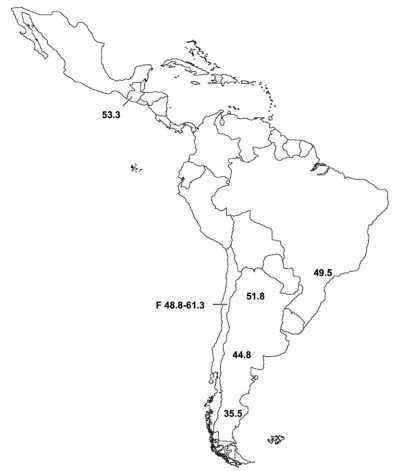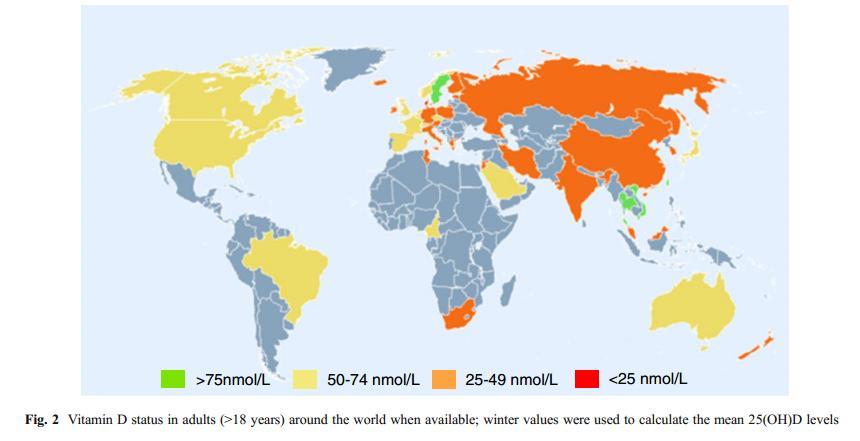Global Vitamin D levels
Worldwide vitamin D status
Best Practice & Research Clinical Endocrinology & Metabolism 25 (2011) 671-680
Natasja M. van Schoor, Ph.D, Senior Epidemiologist a*, Paul Lips, Ph.D, M.D, Professor of Endocrinology b
a EMGO Institute for Health and Care Research, Department of Epidemiology and Biostatistics, VU University Medical Center, Van der Boechorststraat 7, 1081 BT Amsterdam, The Netherlands
b VU University Medical Center, Department of Internal Medicine, Endocrine Section, Amsterdam, The Netherlands
The aim of the present study is to summarize existing literature on worldwide vitamin D status vitamin D levels in adults in different continents and different
25-hydroxyvitamin D countries worldwide.
The best determinant of vitamin D status is the vitamin D deficiency serum concentration of 25-hydroxyvitamin D (25(OH)D).
Most adults investigators agree that serum 25(OH)D should be higher than 50 nmol/l , but some recommend higher serum levels.
Traditional risk groups for vitamin D deficiency include pregnant women, children, older persons, the institutionalized, and non-western immigrants.
This chapter shows that serum 25(OH)D levels are not only suboptimal in specific risk groups, but also in adults in many countries.
Especially, in the Middle-East and Asia, vitamin D deficiency in adults is highly prevalent.
Fig. 1. Mean serum 25(OH)D levels in Europe. The data come from different studies.14 28
A rectangle around the number indicates that it is a population-based study.

Fig. 2. Mean serum 25(OH)D levels from different studies in the Middle-East.30 36

Fig. 3. Mean serum 25(OH)D levels from different studies in Africa.37 43 ) veiled; *) non-veiled.

Fig. 5. Mean serum 25(OH)D levels in Oceania.53 59

Fig. 6. Mean serum 25(OH)D levels in North-America.60-68

Fig. 7. Mean serum 25(OH)D levels in South-America.69-72

Conclusion
Vitamin D deficiency has a high prevalence over the world, not only in risk groups.
Especially, in the Middle-East and Asia, vitamin D deficiency in adults is highly prevalent.
Traditional risk groups include young children, pregnant women, older persons, the institutionalized, and non-western immigrants.
Recent studies show that adolescents and young adults are at risk for vitamin D deficiency.
Risk factors for vitamin D deficiency include low sun exposure, skin pigmentation, sunscreen use, skin covering clothes and a diet low in fish and dairy products.
If registered (free), [tiki-download_file.php?fileId=1965] for PDF
See also Vitamin D Life
Vitamin D insufficiency in UK youths – 37X more likely if dark skin – July 2011
Vitamin D in the UK = Vitamin D Association
2000 IU daily dose of vitamin D would save Germany 37 billion euros – Aug 2010
Vitamin D should Improve mortality in Nordic Countries – Feb 2011 Grant
Recommend 2500-4000 IU per day to reduce all-cause mortality by 18%– Grant Netherlands April 2010
Vitamin D could save More than 10,000 Canadian lives annually LEF
Only 18 % of Swedes got recommended amount of vitamin D – Feb 2011
30 % of US had less than 20 ng of vitamin D - CDC March 2011
Doubling of people less than 30 ng of vitamin D - 75% of whites and 90% of blacks – Feb 2010
Vitamin D levels in healthy populations around the globe – Aug 2012 has the following map and lots of details

